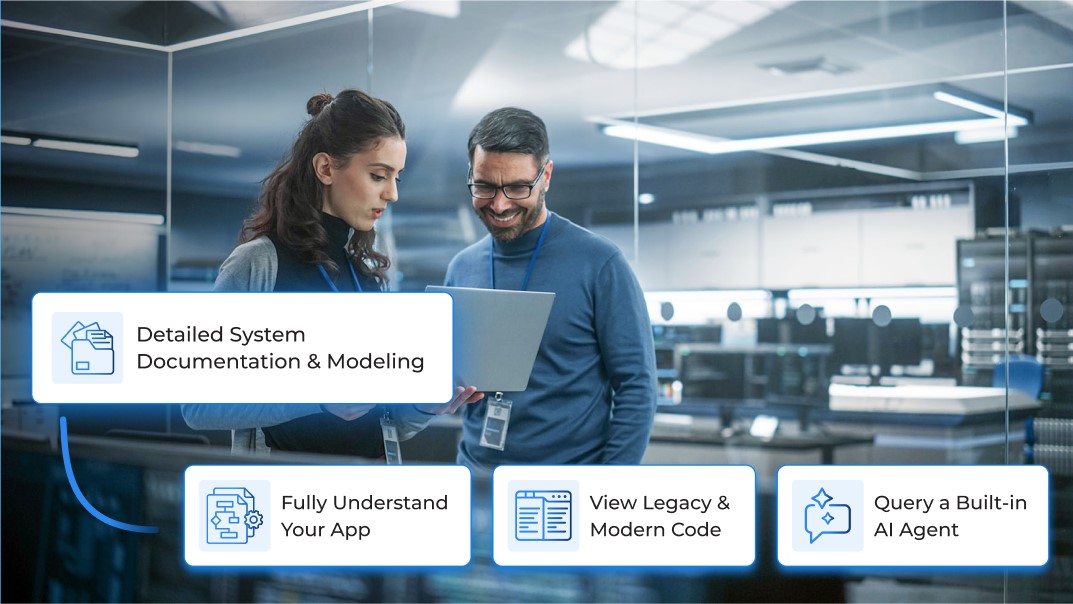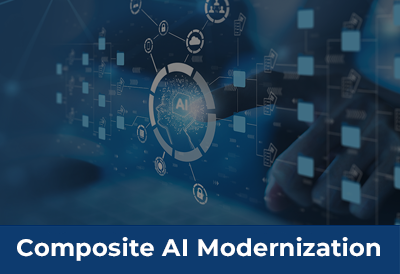Composite AI: The Key to Successful
Enterprise-scale Modernizations
Transform your apps. Innovate without Limits.
Modernizing legacy systems at enterprise scale is no small feat. Organizations are under pressure to reduce operational costs, escape inflexible vendor contracts, and increase agility. To be successful, they must preserve core business logic, enable future adaptability, and migrate to modern environments without disrupting essential business workflows. Meanwhile, IT teams are responsible for maintaining brittle codebases and managing complex integrations to keep operations running while the system is being transformed.
For decades, many have tried to solve the legacy challenge through manual rewrites. However, studies like the Standish Group’s long-running CHAOS Report have consistently shown that these efforts fail more often than they succeed¹. And the odds haven’t improved. A 2024 Forrester report found that 9 in 10 manual rewrite projects failed on the first try, and over half of the participants had attempted to rewrite the same application at least six times².
With such low success rates and ever-mounting pressure to modernize, IT leaders are constantly looking for better ways to solve this age-old problem.
Now, the emergence of Generative AI (GenAI) offers new pathways to break free from the traditional challenges of manual modernization. Solution providers are now exploring GenAI tools to rewrite legacy code, aiming to reduce costs and delivery timelines.
GenAI Unlocks New Possibilities—But Can’t Do It Alone
While early pilots and Proof-of-Concepts (POCs) have shown strong promise, GenAI’s known limitations become more pronounced as legacy applications scale in size and complexity. Large language models (LLMs), though powerful, rely on probabilistic reasoning which cannot guarantee legacy business logic is maintained and there's a lack of visibility into changes within the models creating potential downstream issues. Additional challenges such as token limitations and hallucinations relating to language semantics become extremely difficult to manage across systems with millions of lines of code.
GenAI can accelerate large portions of the modernization process, but most real-world projects report efficiency gains of only 20 – 50%³ leaving a significant amount of manual work for development teams. And as application size increases, so do the demands on human resources leading to the same inefficiencies that make manual rewrites slow, risky, and expensive.
Modernization Without the Pitfalls: TSRI’s Composite AI Approach
After decades of successfully providing automated modernization, TSRI has developed a Composite AI transformation strategy that pairs the speed and precision of Deterministic AI with the insights and recommendations from GenAI to deliver high-performance systems transformed with maximum efficiency and minimal risk. By combining these AI technologies, we can harness the benefits of GenAI while mitigating potential risks—enhancing overall project outcomes.
At the core of our solution is JANUS Studio® AI Platform, TSRI’s Deterministic AI engine. Originally developed in Boeing’s AI lab, this model-driven rules-based engine has been refined over 30 years and used in hundreds of successful modernization projects.
With an industry-leading automation rate of 99.9x%, JANUS Studio delivers guaranteed functional equivalence efficiently—transforming 100% of the code, databases, and user interfaces with total accuracy—deploying fully compiling applications within weeks, not months or years.
This powerful technology supports over 30 source and target languages and enables containerized deployment to cloud-native, hybrid, or on-prem environments, offering unmatched flexibility.
"Everything went so smoothly. The migration—with 40 years worth of data—was done in 12 hours and we didn't have any surprises. We were very confident, going live to all 26,000 users, and saw only two trouble tickets that first week. The CFO system successfully paid out $2 Billion in the first 30 days with no problems whatsoever."
JANUS Studio has become the trusted transformation backbone for many of the world’s leading systems integrators—consistently delivering on time and helping customers achieve 80–90% reduction in their total cost of ownership (TCO) and meeting or exceeding performance expectations, when moving off the mainframe and legacy environments, with minimal to no business disruption.
Building on that proven foundation, TSRI now layers GenAI strategically throughout the modernization lifecycle. Leveraging structured knowledge graphs and metadata generated by JANUS Studio, GenAI supports deep system understanding through interactive AI agents. This results in future-ready systems built on modern technology stacks and maintained with highly efficient development tools and deployment pipelines.
TSRI has been recognized as an industry leader multiple years running in the ISG Provider Lens™ Mainframe – Services and Solutions Mainframe Application Modernization Software Quadrants for US and Europe as one of the most comprehensive automated solutions available.
"TSRI has unique capabilities around source and destination languages, providing more options and better quality. It is one of the few vendors that offers a code warranty, no license fees and multiyear support to optimize application performance."
— Pedro L. Bicudo Maschio,
Lead Author and Principal Analyst, ISG Provider Lens™ Mainframe – Services and Solutions Mainframe Application Modernization Software Quadrants, US
Here’s What You Get with TSRI’s Composite AI
From the moment a modernization initiative begins, TSRI’s Composite AI approach brings structure, clarity, and momentum to every phase. Whether you're starting with early system assessments or aligning cross-functional teams on objectives, our process ensures that every stakeholder—from business leaders to DevOps teams—is supported by a unified, AI-driven strategy designed for success.
Documentation: Deep System Understanding
One of the primary reasons modernization efforts fail is a lack of system understanding at the outset. When teams dive in without a precise, shared grasp of the “as-is” system, core business logic is at risk, planning becomes guesswork, and costly misalignments among stakeholders and business requirements are inevitable.
That's why every TSRI transformation starts with AI-driven, human readable business documentation featuring a built-in agent for rapid responses to any query about an application. This artifact promotes awareness and alignment across business and technical teams, laying the foundation for a collaborative modernization process.
Another key deliverable early in the modernization process is an Application Blueprint®—a complete, accurate model of the legacy system. Using JANUS Studio we analyze the entire codebase—down to every interface, dependency, and function—and generate detailed UML-level, web-based documentation and knowledge graphs that scale to any application size or complexity.
During the assessment phase, we also generate a powerful Transformation Blueprint®—a forward-looking map that connects source languages to proposed target languages.
This visibility into the code provides deep technical clarity for engineers and application owners, informing their modernization strategy and helping to ensure a successful outcome.
Detailed system documentation enables enterprises to plan efficiently—from initial assessment, milestone development, and resource allocation to transformation, validation, deployment, and even future innovation.
"The documentation TSRI provided—with strong correlation between the source and target code—helped our COBOL developers quickly understand the modernized system and step into new roles as functional requirements leads. It also made onboarding new Java developers easier, and enabled a faster, more consistent monthly release cadence to support innovation and long-term system maintenance."
After the transformed application is validated and deployed, this blueprint becomes a perpetual representation of the modernized system. With the "as-is" and "to-be" code displayed side-by-side and hyperlinked, it illustrates how each component was translated and visually shows functional equivalence in the code. It can be continually refreshed to support ongoing updates making it a powerful asset that enables faster developer onboarding, safe innovation, and long-term maintainability.
How Deterministic AI Delivers
⟶ Built to Understand, Not Guess
JANUS Studio constructs a precise model of your code, interfaces, and dependencies—eliminating the surprises that commonly derail projects.
⟶ Full-System Mapping Constructs
A knowledge graph that provides a comprehensive structural map for deep application analysis and semantic context.
⟶ Auditable & Repeatable
Every transformation is documented, repeatable, and linked back to the legacy source code—ensuring provable equivalence and full transparency.
⟶ Structured Documentation
Automatically generates UML models, control-flow graphs, and metadata that enable a shared knowledge base for engineers, stakeholders, and AI agents alike.
⟶ Proactive Risk Reduction
Surfaces hidden dependencies early helping teams mitigate roadblocks before transformation begins.
How GenAI Adds Value
While JANUS Studio produces highly detailed and technically precise documentation, it can be dense and cumbersome for some stakeholders to interpret. That’s where TSRI’s integration of GenAI comes in.
Leveraging the knowledge graphs and metadata extracted from the source code by JANUS Studio, GenAI can generate human-readable business documentation and provide system context for real-time agent-based support.
⟶ Human-Readable Insights
LLMs with custom prompts produce business-level summaries at the program and paragraph level—enabling mutual understanding across business and technical stakeholders.
⟶ Business Logic Transparency
Overlays business-level context onto system flow graphs, connecting high-level requirements to specific code paths.
⟶ Real-Time System Queries
Interactive agents informed by knowledge graphs, are enhanced with vector search and semantic modeling to surface logic chains, dependencies, and architectural relationships.
⟶ Test & Triage Queries
Application agents allow engineers to query the system using natural language to triage issues and enhance test protocols.
⟶ Smarter Legacy Replacements
AI agents can suggest modern alternatives for legacy components like middleware or services tailored to your enterprise’s architectural goals and governance standards.

Transformation: Guaranteed Accuracy at Scale
Legacy systems were built for stability and speed, not rapid change. Today’s environment demands agility, responsiveness, and resilience.
While mainframes remain powerful, their batch-oriented structures and rigid, often monolithic architectures can limit how quickly organizations adapt, innovate, and integrate with modern platforms.
Most organizations need to modernize quickly, and many want to optimize their systems at the same time. Moving off the mainframe, either partially or completely, is only part of the goal.
At TSRI, we understand that functional equivalence is not an end goal—it’s an inflection point. As parity in the modern environment is achieved, the transformed system can be deployed incrementally, validating each deployment against real-world usage, and then systematically optimized and redeployed—all without disrupting ongoing business or mission operations. Achieving functional equivalence first provides a solid foundation with the continuity and precision needed to continue operating at the enterprise level, with a velocity that promises a faster path to future innovation.
“TSRI was able to show that a rapid, highly accurate modernization from mainframe COBOL to Java is possible on even critical, complex projects such as those with HUD.”
How Deterministic AI Delivers
TSRI’s proven transformation engine, JANUS Studio, sits at the heart of our Composite AI solution. This language-neutral model applies formal methods and thousands of tested transformation patterns to deliver accurate, repeatable and scalable results—even across the most complex legacy environments.
⟶ 99.9x% Automation. 100% Modernization
Entire applications (UI, business logic, and data layers) transformed with deterministic precision and 99.9x% automation, reduces risk of errors (typically <1 defect manually patched per 20K LOC)
⟶ Proven Foundation for Innovation
Preserving all business logic and proving functional equivalence first enables early validation and lays the groundwork for future enhancements.
⟶ Formal Methods for Confidence
Creates a deterministic model of the system—ensuring transparent and repeatable results with zero risk of probabilistic hallucinations.
⟶ Scalability & Velocity
Built for large portfolios, JANUS Studio can modernize millions of lines of code in days. (Case in point: 17.5 million lines of COBOL to Java transformed and compiled in just three days.)
⟶ Create or Expand Test Protocols
Extracts structured metadata from the legacy application that support the creation of comprehensive test suites.
⟶ Cloud-Native & DevSecOps-Ready
Transformed code is containerized for modern CI/CD pipelines and designed for microservices orchestration—ready to meet business needs with responsive updates and secure, scalable cloud deployment.
How GenAI Adds Value
While JANUS Studio ensures structure, accuracy, and integrity, TSRI augments the transformation phase innovative suggestions from GenAI to elevate outputs.
⟶ Domain-Specific Code Expression
GenAI can analyze chunks of code to identify potential improvements and recommend modern patterns in the target language. These domain-specific enhancements can be consistently applied across the codebase using rules built directly into JANUS Studio.
⟶ Agent-Based Transformation Strategy
GenAI agents deliver real-time interactive insights powered by knowledge graphs generated by JANUS Studio complete with logic, relationships, and structure, enabling teams to plan and validate transformation strategies.
⟶ Test Case Acceleration from Metadata
Using rich metadata extracted by JANUS Studio—including job names, step logic, program IDs, control card files, and input dependencies—GenAI can assist with test case creation and functional equivalence validation.

Refactoring: From Technical Debt to a Resilient, Modern Architecture
Legacy systems often contain deeply nested logic, obsolete patterns, and tight coupling between layers making regular changes difficult, risky, and costly, limiting both growth and innovation. While like-for-like modernization may preserve the past, TSRI’s Composite AI empowers organizations to prepare for the future by refactoring applications into modular, flexible architectures that are designed to be easily maintained and adapted to evolving business objectives.
"Deutsche Bank selected TSRI due to its overall quality of code during the POC phase and their automated refactoring capabilities, which improved the output even further."
How Deterministic AI Delivers
Using formal methods and a vast library with thousands of refactoring rules, JANUS Studio automatically identifies and eliminates redundant code, dead code, obsolete constructs, and resolves duplicate and consolidates similar records and code—preserving all functionality while consolidating code, improving performance, and ensuring maintainability.
⟶ Structural Optimization for Modern Architectures
Code is reorganized into modular, reusable structures featuring object-oriented and service-oriented patterns to support the implementation of modern API strategies across both internal and external interfaces.
⟶ Domain-Specific Enhancements
Thousands of time-tested refactorings with domain-specific configurations and custom options are built into JANUS Studio; reusable across enterprise portfolios.
⟶ Performance & CPU Efficiency Refactoring
JANUS Studio detects workload and logic inefficiencies—optimizing flow control, input/output operations, CPU utilization, and memory usage to improve runtime performance and reduce operational costs.
⟶ Flexible Architectures, Built to Scale
JANUS Studio applies architectural refactorings that decouple rigid logic and redesign monolithic structures, enabling applications to dynamically scale efficiently while maintaining performance across enterprise workloads based on user demand and data growth.
⟶ Code Quality & Issue Remediation
TSRI leverages SonarQube and other code quality tools to surface code smells, bugs, and vulnerabilities. Rules are then developed and automatically applied at scale to remediate issues and achieve AAAA scores.
⟶ Strategic Cloud Deployment Flexibility
Refactored architectures support phased deployment across public, private, hybrid, or multi-cloud environments—enabling cost optimization (often achieving 80-90% TCO reduction) and long-term infrastructure agility.
"We were able to achieve about a 90% reduction in total costs. We started at 30 million prior to the modernization and ended at about 3 million, post-modernization."
How GenAI Adds Value
GenAI works alongside JANUS Studio to bring creativity, context, and business-level insight to the automated rules-based refactoring process, optimizing the system and driving innovation.
⟶ Modern Design Enhancements
Deterministic knowledge graphs help LLMs gain system context—enabling forward-looking architectural suggestions and modern design strategies that JANUS Studio can validate and apply with consistency and accuracy.
⟶ Creative Restructuring
GenAI-based agents propose alternative design patterns for tightly coupled components to improve system flexibility.
⟶ Business-Aware Optimization
Analyzing the knowledge graphs, GenAI Agents can identify opportunities to further reduce technical debt, and better align architecture with long-term business goals.
⟶ Continuous Innovation & Agent-Based Assistance
After transformation, GenAI agents support future innovation and ongoing maintenance with real-time feedback through interactive AI agents and vector search.
Guaranteed Success & Long-term Support Through Composite AI
Modernization isn’t just about removing legacy risk or lowering costs—it’s about enabling whatever comes next for your organization. That means designing modern systems that can scale, respond, and evolve alongside shifting market demands. Getting there quickly and successfully requires true system understanding, strong collaboration, and proven modernization technology.
We stand behind every modernization with a level of confidence few other providers can match with transformation warranties and managed service offerings.
"TSRI has unique capabilities around source and destination languages, providing more options and better quality. It is one of the few vendors that offers a code warranty, no license fees and multiyear support to optimize application performance."
Ready to Get Started with Your Composite AI Transformation?
Our modernization experts would love to show you what's possible
Watch Now: Future-Driven Modernization with Composite AI
Hear from TSRI Chief Technology Officer, Scott K. Pickett, in his presentation at the 2025 Gartner Application Innovation & Business Solutions Summit, in Las Vegas. Learn how TSRI combines Deterministic AI and GenAI to accelerate complex transformations—featuring real-world insights from a recent enterprise modernization success story.
Sources:
- https://www.prnewswire.com/news-releases/new-multi-decade-research-indicates-continual-modernization-programs-are-key-to-it-success-301183280.html
- https://www.rocketsoftware.com/sites/default/files/resource_files/rocket-it-modernization.pdf
- https://www.mckinsey.com/capabilities/quantumblack/our-insights/ai-for-it-modernization-faster-cheaper-and-better



